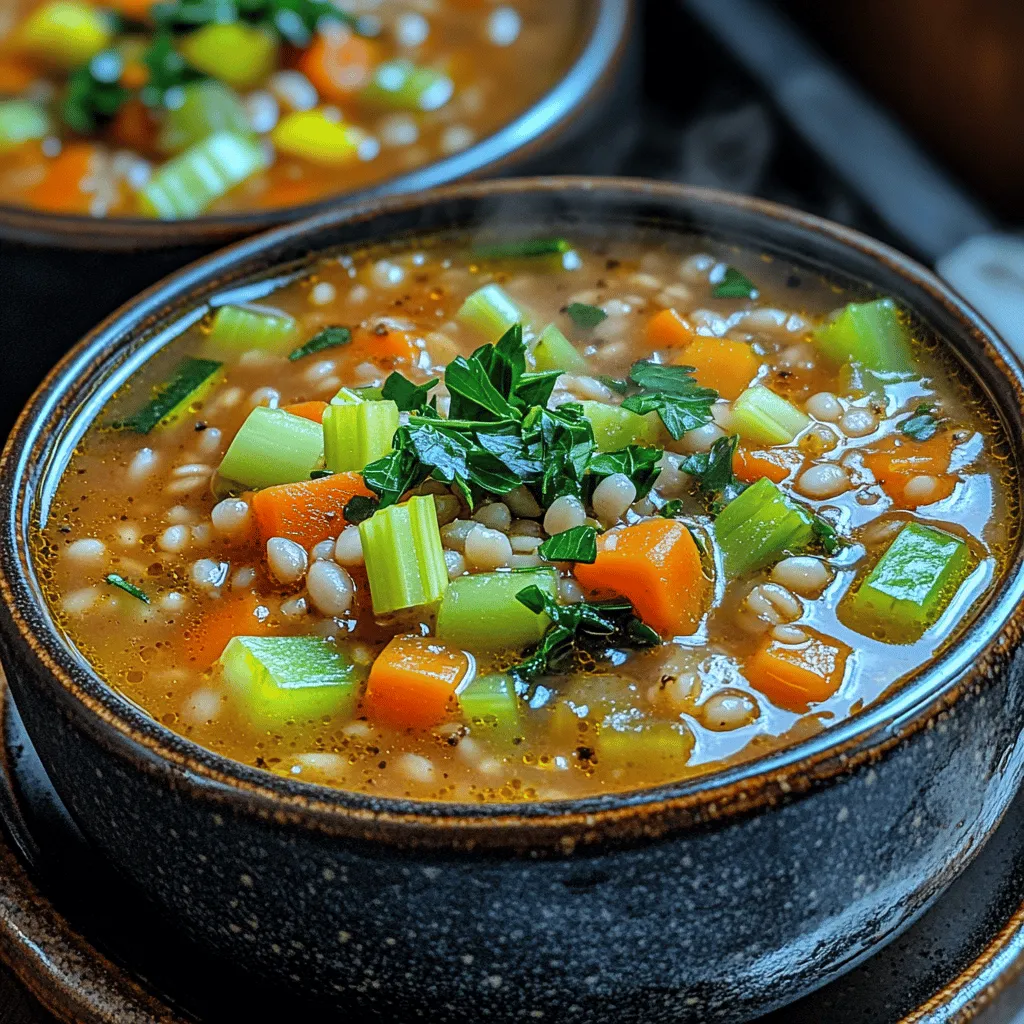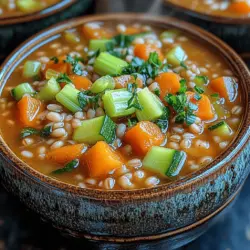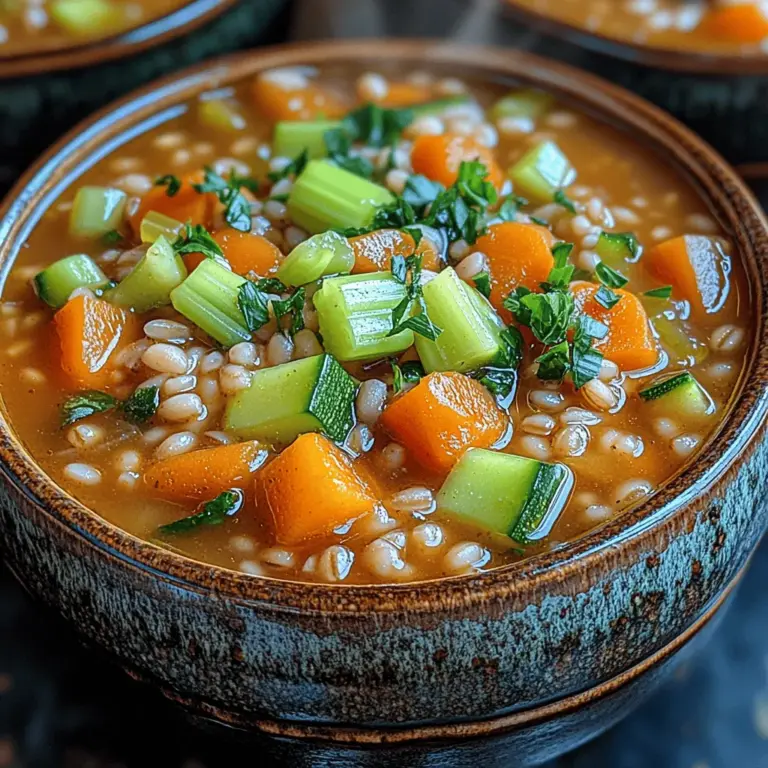Introduction
As the days grow shorter and the air turns crisp, there’s nothing quite like a bowl of homemade soup to warm the soul. Among the myriad of soup recipes, Hearty Vegetable Barley Soup stands out not only for its rich flavors and comforting texture but also for its exceptional health benefits. This recipe beautifully combines the wholesome goodness of vegetables with the nutritional powerhouse that is barley, making it an ideal choice for those looking to nourish their bodies during the colder months.
Barley is often overlooked in the grain aisle, yet it offers a wealth of nutrients that elevate this soup from ordinary to extraordinary. Its chewy texture and nutty flavor are complemented by a colorful medley of fresh vegetables, creating a dish that is both satisfying and nourishing. This soup is more than just a meal; it’s a celebration of seasonal produce and wholesome ingredients that work together harmoniously, providing warmth and comfort in every spoonful.
Understanding Barley: A Nutritional Powerhouse
When it comes to grains, few can match the nutritional profile of barley, particularly pearl barley. This versatile grain is packed with dietary fiber, which is essential for digestive health and helps keep you feeling full longer. In fact, a single serving of cooked barley contains about 6 grams of fiber, making it a fantastic choice for those looking to maintain a healthy weight or support their digestive system.
In addition to its impressive fiber content, barley is rich in vitamins and minerals, including B vitamins, iron, magnesium, and selenium. These nutrients play vital roles in maintaining overall health, from supporting energy levels to boosting the immune system. Barley also has a low glycemic index, meaning it can help regulate blood sugar levels, making it a great option for those managing diabetes.
When comparing barley to other grains, such as rice or wheat, its nutritional benefits become even more pronounced. While white rice is primarily a source of carbohydrates with minimal fiber, barley offers a more balanced nutrient profile, making it a smarter choice for those looking to enhance their diet. This unique combination of health benefits is what makes barley a star ingredient in our Hearty Vegetable Barley Soup.
Choosing Fresh Ingredients for Your Soup
One of the keys to creating a delicious Hearty Vegetable Barley Soup lies in the quality of the ingredients you choose. Using fresh, seasonal vegetables not only enhances the flavor of your soup but also boosts its nutritional value. Fresh produce is packed with vitamins, minerals, and antioxidants that can support your health and wellbeing.
When selecting vegetables for your soup, consider what’s in season. In the fall and winter months, root vegetables such as carrots, parsnips, and sweet potatoes are abundant and add a natural sweetness to your dish. Leafy greens like kale or spinach can also be great additions, providing an extra dose of nutrients. You can also incorporate seasonal favorites like butternut squash or Brussels sprouts to add depth and variety.
To ensure you’re choosing the best produce, keep the following tips in mind:
– Look for vibrant colors: Fresh vegetables should be bright and colorful. Dull or faded produce may indicate that it’s past its prime.
– Check for firmness: Choose vegetables that are firm to the touch, as this often indicates freshness. Avoid any that are soft or have blemishes.
– Smell the produce: Fresh vegetables often have a pleasant, earthy aroma. If they smell off or have an unpleasant odor, it’s best to steer clear.
By using fresh, seasonal ingredients, you’ll not only enhance the flavor profile of your Hearty Vegetable Barley Soup but also ensure that you’re reaping the maximum health benefits from each ingredient.
Step-by-Step Guide to Making Hearty Vegetable Barley Soup
Sautéing the Aromatics: Building Flavor Foundations
The journey to a delicious bowl of Hearty Vegetable Barley Soup begins with sautéing the aromatics—specifically, the onion and garlic. These two ingredients are essential for laying the flavor foundation of your soup. When sautéed, they release their natural oils and flavors, infusing the broth with depth and richness.
To start, heat a tablespoon of olive oil in a large pot over medium heat. Once the oil is shimmering, add a diced onion. Sauté the onion for about 5-7 minutes, or until it becomes translucent and starts to caramelize. This caramelization process is crucial, as it enhances the sweetness of the onion and adds a beautiful depth of flavor to your soup.
Next, add minced garlic to the pot and sauté for an additional minute. Garlic cooks quickly, so be sure to keep an eye on it to prevent burning. The moment you add garlic, you’ll notice its aromatic scent wafting through the kitchen, signaling that you’re on the right track.
Adding Vegetables: The Color and Nutrition Factor
With the aromatics sautéed to perfection, it’s time to add the star of the show: the vegetables. This is where you can get creative with your choices, incorporating a variety of colorful veggies to boost both nutrition and visual appeal. Carrots, celery, bell peppers, and zucchini are all excellent options that can be included in your soup.
Chop your selected vegetables into bite-sized pieces and add them to the pot, stirring to combine. Sauté the vegetables for another 5-10 minutes, allowing them to soften and absorb the flavors from the onion and garlic. The vibrant colors of the vegetables not only make the soup more visually appealing but also indicate a range of nutrients, each with its own health benefits.
It’s worth noting that you can easily adjust the vegetable combination based on the seasons or your personal preferences. For instance, during the summer months, you might opt for fresh green beans and corn, while in the winter, root vegetables can take center stage. The flexibility of this recipe allows you to customize it to suit your taste and the ingredients available to you.
Incorporating Barley: Techniques for Perfect Texture
Now that your vegetables are sautéed and fragrant, it’s time to introduce the barley. Before adding it to the pot, it’s essential to rinse the barley under cold water to remove any dust or debris. This simple step can make a significant difference in the final texture of your soup.
For an extra layer of flavor, consider toasting the barley in the pot. To do this, simply add the rinsed barley to the pot after sautéing the vegetables, stirring it for about 2-3 minutes. This technique enhances the nutty flavor of the barley and helps to create a richer broth once the liquid is added.
Once toasted, proceed to add your vegetable broth or water to the pot, ensuring that the barley is fully submerged. This is where the magic happens—bringing together all the flavors and ingredients into a warm, nourishing soup that will delight your senses.
As you can see, the process of making Hearty Vegetable Barley Soup is not only straightforward but also allows for plenty of creativity and customization. Each step builds upon the last, creating a harmonious blend of flavors and textures that will leave you feeling satisfied and nourished.
In the following sections, we’ll delve deeper into the cooking process, additional ingredient options, and tips for storing and serving this delightful soup. But for now, enjoy the comforting aroma of your Hearty Vegetable Barley Soup as it simmers, filling your home with warmth and anticipation for the delicious meal that awaits.


